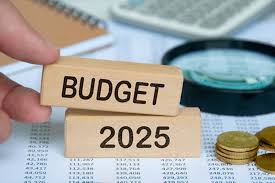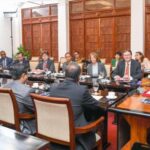
Sri Lanka’s Economic Future: Navigating the 2025 Budget and Challenges Ahead
- CNL Reporter
- November 23, 2024
- Weekly Economic Review
- Sri Lanka’s Economic
- 0 Comments
Weekly Economic Review
As Sri Lanka prepares to present its 2025 budget, the government is at a crucial juncture. The economic landscape remains complex after a prolonged financial crisis, but there is a renewed focus on stabilizing the economy, managing debt, and fostering development. The 2025 Appropriation Bill, set to be unveiled in March, carries significant implications for the country’s fiscal direction and recovery.
Provisional Estimates for the 2024 and 2025 Budgets
The Finance Ministry has outlined provisional estimates for the 2024 budget as a precursor to the detailed 2025 budget. These estimates are crucial for setting targets that balance fiscal discipline with economic growth.
In 2025, the government aims to increase revenue to 15.1% of the Gross Domestic Product (GDP) while keeping expenditures capped at 20% of GDP. This approach reflects a strategy to consolidate economic stability, especially after the challenges of recent years.
The budget’s key objectives include:
Revenue Target: 15.1% of GDP in 2025, roughly Rs. 3.9 trillion.
Expenditure Cap: 20% of GDP, or around Rs. 5.2 trillion.
Budget Deficit Goal: Below 5% of GDP.
Primary Budget Surplus: 2.3% of GDP, crucial for debt management.
Increased Capital Expenditure: Over 4% of GDP, focusing on projects that stimulate economic growth.

These targets are part of the government’s broader fiscal strategy to promote long-term recovery. There is an emphasis on completing existing projects efficiently to prevent delays and cost overruns, ensuring that capital investments contribute meaningfully to economic development.
Fiscal Performance in 2024 and Projections for 2025
For 2024, Sri Lanka’s revenue performance has already exceeded initial expectations. The government’s initial target was a revenue-to-GDP ratio of 13.02%, based on a projected GDP of Rs. 31,500 billion and a revenue estimate of Rs. 4,100 billion.
Adjustments during the year, with GDP revised to Rs. 30,000 billion, pushed the actual revenue-to-GDP ratio to 13.67%. This represents an overperformance of 0.67%, equivalent to an additional Rs. 201 billion in revenue—a positive indicator for the government’s fiscal management.
For 2025, the Ministry of Finance has set ambitious targets, aiming for a revenue collection of Rs. 5,000 billion. The projected GDP figures range between Rs. 33,000 billion and Rs. 34,500 billion, leading to estimated revenue-to-GDP ratios of 15.15% and 14.49%, respectively.
Both scenarios exceed the International Monetary Fund (IMF) targets, indicating that Sri Lanka is on track to meet its fiscal commitments.
Adjustments in Taxation and Revenue Projections
The 2025 budget will include several adjustments that may impact revenue collection. A proposed increase in the tax threshold from Rs. 100,000 to Rs. 200,000 and a reduction in tax rates could reduce revenue by Rs. 70-80 billion. Additionally, exemptions on Value Added Tax (VAT) for essentials like school supplies and baby food are expected to cause a further revenue decrease of Rs. 70-80 billion.
Overall, these tax adjustments may lead to a total revenue shortfall of around Rs. 150 billion in 2025. However, given the strong revenue performance in 2024, this shortfall is considered manageable.

Balancing Economic Priorities amid Debt Concerns
Sri Lanka’s debt crisis, which began in 2022, continues to pose significant challenges. The high interest-cost-to-revenue ratio, currently the highest globally, underscores the urgency of achieving sustainable fiscal targets. Key goals for the 2025 budget include:
Maintaining Primary Expenditure Below 13% of GDP: This target aims to ensure efficient use of public funds and to support sustainable spending.
Enhancing Revenue from State-Owned Enterprises: Improving the financial performance of public enterprises is a core component of the strategy to stabilize the economy.
Implementing Reforms: Legislative and institutional changes are planned to strengthen fiscal management, particularly around revenue collection and expenditure oversight.
The IMF has been a key partner in Sri Lanka’s economic stabilization efforts, emphasizing the need for effective revenue measures and spending restraint. Meeting these objectives is critical to ensuring debt sustainability and securing future financial support.
Political Changes and Their Impact on Economic Policy
The political landscape in Sri Lanka has shifted significantly following the recent Presidential and Parliamentray elections. The new administration, led by President Anura Kumara Dissanayake of the National People’s Power (NPP) party, has committed to a recovery agenda that prioritizes inclusive growth. However, this shift has also led to policy changes that could affect the economic trajectory.

In a notable move, the government reversed a significant reform tied to the IMF bailout plan, particularly concerning state-owned enterprises. The decision to overturn the Electricity Act—intended to privatize parts of the Ceylon Electricity Board (CEB) and increase renewable energy generation—reflects the new administration’s alignment with trade union interests. This policy reversal highlights the balancing act between maintaining public support and adhering to international financial commitments.
Debt Restructuring and International Negotiations
As part of its recovery strategy, Sri Lanka is nearing the completion of a crucial foreign-currency debt restructuring process. The goal is to ease the burden on local banks and improve their financial stability, potentially enhancing the country’s creditworthiness and facilitating access to foreign funding. The government is in negotiations with major creditors, including Japan, China, and India, to restructure approximately $12.5 billion in debt.

Successfully navigating this restructuring is vital for stabilizing the economy and restoring investor confidence. Improved credit ratings for Sri Lankan banks would follow, reflecting positively on the broader financial sector, given the banks’ significant exposure to government securities and public-sector loans.
Challenges Ahead and Future Outlook
Despite recent fiscal successes, significant challenges remain. Sri Lanka’s economic recovery depends heavily on effective policy implementation and international cooperation. The government’s ability to navigate debt restructuring, implement reforms, and maintain spending discipline will be critical factors in the country’s economic stability.
The IMF’s just cocluded review of Sri Lanka’s reform program, which includes conditions for securing the next installment of a $2.9 billion loan, underscores the importance of meeting specific fiscal targets. Positive outcomes from these discussions are essential for continued financial support, but the new administration’s policy shifts could complicate the process.
Conclusion: A Path Forward for Economic Stability
The 2025 budget represents a critical moment in Sri Lanka’s journey from crisis to recovery. The government’s focus on fiscal discipline, revenue growth, and targeted investments aims to foster sustainable development. However, the road ahead requires careful management of economic priorities, public expectations, and international obligations.

As the country moves forward, the balancing act between economic reforms and maintaining social stability will remain at the forefront of policy discussions. The 2025 Appropriation Bill is not just a budget—it’s a blueprint for Sri Lanka’s future, and its success will depend on the government’s ability to translate targets into tangible outcomes for the economy and the public

